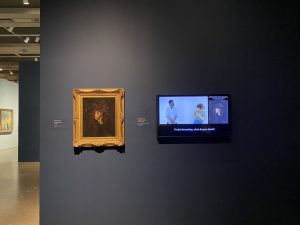1 What is Visual Culture?
J. Keri Cronin and Hannah Dobbie

Introduction
It is no exaggeration to say that we are surrounded by images. Take a look around you now. How many different kinds of images do you see at this moment? Think back on all of the images you encountered so far today. Can you bring them to mind? Is it possible you didn’t even notice some?
From the moment we wake up in the morning we are inundated with images. Perhaps you scrolled through social media as you ate your breakfast. Were there colourful images on the box of cereal in front of you? Do you have posters or framed family photographs in your living space? On your way to work or school you likely passed advertisements, billboards, and window displays in your local shops. Does your bus pass or parking pass have a logo or image on it? Did you stop to take a picture of your cat curled up in a patch of sun? Did your professors use images or graphs on the slides they showed in your classes today? Is there an image on the cover of the textbook in your backpack? A logo on your jacket?
We are surrounded by images on a daily basis–some would even say we are overloaded by images! However, we don’t often stop to think critically about them. Learning to think about how images work and make meaning in our societies opens our eyes to many important social, cultural, ethical, economic, political, historical, and technological issues.
Images can help us make sense of the world. They can challenge ideas, but they can also reinforce dominant ideas and the status quo. And the meanings generated by images can be complex. How do we negotiate this?
When we talk about studying visual culture we simply mean that we are focusing our learning, research, and scholarly inquiries on images. Studying visual culture in an academic context involves thinking critically and seriously about pictures and about how they make meaning in our world. We live in a very visual world and yet we are rarely given the opportunity to learn about the ways that images make meaning.
When we use the term “visual culture” we are typically referring to visual representations of something. So, your adorable baby niece isn’t an example of visual culture (she is a living being!), but the photograph of her on the invitation to her 1st birthday party is an example of visual culture. Your cat isn’t an example of visual culture, but the cartoon cat on the bag of cat food he enjoys would be. A forest isn’t an example of visual culture, but a map of the hiking trails that run through it would be. In each of these cases, the living thing (baby, cat, forest) is represented in a way that conveys specific information (a happy child, a hungry cat, a way to safely navigate the forest). In each of these cases, the representation of the baby/cat/forest offers a select interpretation of that living thing (your niece isn’t always grinning is she?), and it is this process of interpreting something complex through an always incomplete process of representation that we are interested in investigating in this course. The way an image looks, the choices the artist/image-maker made, and where the image is viewed shapes how we understand it. As we will see, there are also complex political, social, and technological issues that inform what Marita Sturken and Lisa Cartwright have termed the “practices of looking.”[1]
Images as “Active Players”
You will note that we were very deliberate about our use of language in the previous paragraph–we wrote that “images make meaning” not that they have meaning. Our point here is that pictures don’t come preloaded with a single, fixed meaning that we have to learn to decipher and decode. Rather, as W.J.T. Mitchell writes, images are “active players in the game of establishing and changing values.”[2]
What does Mitchell mean here? Let’s dig in further. In his book What Do Pictures Want?: The Lives and Loves of Images, Mitchell argues that:
“we don’t just evaluate images; images introduce new forms of value into the world, contesting our criteria, forcing us to change our minds… Images are not just passive entities that coexist with their human hosts, any more than the microorganisms that dwell in our intestines. They change the way we think and see and dream.”[3]
To think of a picture as an “active player” might seem a bit odd at first, but Mitchell is not suggesting that an image is alive in the same way that, say, a puppy is.

Pictures don’t have sentience, they don’t have central nervous systems. But their very presence can influence, reinforce, challenge, and shift ideas. They can make us question what we think we know. They can be the cause of new understandings or ways of seeing the world. They can give us information. They might make us angry, sad, happy, or intrigued. And each person viewing that picture might have a different response. There is a beautiful complexity when we start to think about how pictures function in our world. And once we start to understand this, we can transpose this understanding to any image we encounter in our world.
You might be thinking “well, a picture doesn’t do all of that. The artist or person who made it does!” We will delve into this point in more detail a little later in this course, but for now we will just say that the meaning an artist or image maker intends a picture to have isn’t always the one that a viewer receives.
Let’s look at a quick example to help illustrate this point. The image below was taken by a photographer named Caroline Gunn and it is part of the Wellcome Collection, a museum, library, and archive based in London, England that focuses on health, science, and medicine.

The information accompanying this image on the Wellcome Collection’s website doesn’t give us much context about why Caroline Gunn took this image. We don’t have any information about who this little mouse is, but we can infer from the title (“Mouse Health Check”) that the mouse is being handled carefully and gently by the person performing the health check. Is this mouse a pet? Is the human a veterinarian? Does this animal live in a laboratory? We don’t know, but given that it is part of the Wellcome Collection we can assume that this picture has something to do with science, medicine, or health.
Even though there are gaps in the information we have about this picture, we still bring our knowledge, assumptions, perspectives, understandings, backgrounds, feelings, and emotions to these pictures. Some people might see this picture and smile because they think this mouse is really cute. Others might be afraid of mice and recoil a little when they look at it. Some might be reminded of a pet mouse they once had while others might be thinking of the time they had to rescue a mouse from the jaws of their overzealous housecat. If you are an animal rights activist this image might make you uneasy–perhaps this mouse is about to be the subject of a scientific experiment.
I’m sure we can add to this list of possible reactions to this photograph, but the point here is that even though Caroline Gunn would have had an idea about what she wanted to express through this photograph, other meanings are being generated as we look at it. The picture, in other words, is playing an active role.
Still unsure or unconvinced? We will be returning to this concept of pictures being dynamic participants in the meaning-making process throughout this course.
How is Visual Culture Different From Art History?
Visual culture is related to art history, but the field of inquiry is expanded. Art history has traditionally been concerned with things like the biographies and motivations of artists and/or the formal style of an image. Further, art history tends to be very limited in terms of the kinds of images focused on–typically painting, drawing, and sculpture considered to be “great masterpieces” and “things in art galleries.”
Visual culture, on the other hand, is concerned with a very broad scope of images and image makers. Famous paintings found in art galleries can certainly be the subject of visual culture inquiries, but so can advertisements, social media images, sports logos, cartoons, and passport photos (to name just a few examples). Visual culture scholars ask a very broad range of questions when they work with images and focus their inquiries on how images make meaning in the world.
Visual Culture and Accessibility
In recent years we have seen new initiatives in the fields of art history and visual culture in terms of attempting to be more accessible for a wider audience. Museums and art galleries are often leading the way on this front. For example, the Art Gallery of Ontario (AGO) uses an app called BlindSquare to provide exhibition and wayfinding information for visitors who are blind or partially sighted. The Dallas Art Museum has established a program where visitors who have Color Vision Deficiency (often known as “color blindness”) can borrow a set of lenses that can help visitors to the gallery “view the world with a more enriched color field.”[4]
Another example of accessibility initiatives in the context of viewing images comes, once again, from the Art Gallery of Ontario (AGO). For their summer 2023 exhibition called Cassatt-McNicoll: Impressionists Between Worlds, the AGO included an American Sign Language Video that offered supplementary information about the life and work of Helen McNicoll presented by Peter Owusu-Ansah and Rae RezWell. Owusu-Ansah and RezWell are Deaf visual artists, as was McNicoll.

Collection of the Author
Reflection Exercise
Have a listen to this episode of Art Matters which features an interview with representatives from VocalEyes, a charity in the UK that brings “art and culture to life for blind and visually impaired people at theatres, museums, galleries, heritage sites and online.”
Take 5-10 minutes to do some freewriting on this topic. What did you find the most interesting or surprising about the information presented in this podcast? Does this topic raise any questions for you? Are you interested in thinking further about the topic?
Who Should Study Visual Culture?
Visual culture is something that relates to every subject of study. Even if you are not planning to major in art or visual culture you can develop skills that can help you in your chosen field of study. Are you a history major? What can those old photographs in the archives tell you about your subject? Are you a science major? Why do scientific illustrations look the way that they do? Do you plan to be a teacher? How can images help children learn in the classroom? The list is endless! Developing skills that help us analyse images can be very useful no matter where your academic studies and career take you!
Writing Exercise
- Make a list of some of the ways that images relate to your field of study. (examples: logos, advertising, data visualisation, works of art, film adaptations of novels, medical imaging technologies, etc.)
- Pick one item from your list above. Can you think of a specific example of this type of image? What does it look like? What details stand out in your memory? Where did you see it? How does it make you feel? How does this example relate back to your larger field of study?
Spend 5-10 minutes on this exercise.
Learning to look carefully and to ask questions about what you see is a very important skill to have. For example, many medical schools are now requiring their students to take courses in art history and/or visual culture so that they become more skilled at careful looking and detailed observation. Studying visual culture can lead to career paths in the arts, media, museums, advertising, social media, etc., but more importantly this kind of learning can help you become a more astute consumer of the images that you see every single day.
Becoming a critical thinker when it comes to assessing and analysing images can help you judge whether what you read online or see on television is credible. While there is a long history of images being manipulated and edited, this has become an even more complex topic with the rise of AI tools in recent years.
Critical Thinking
You will often see the phrase “critical thinking” or “thinking critically” in these pages. What do we mean by these terms?
bell hooks describes critical thinking as “discovering the who, what, when, where, and how of things–finding the answers to those eternal questions of the inquisitive child–and then utilizing that knowledge in a manner that enables you to determine what matters most.”[5]
Critical thinking does not necessarily mean taking a negative stance or perspective. It is very possible–and quite desirable, actually–to think critically about an image or an idea you are excited about or really enjoy.
Critical thinking is an important concept in the Arts and the Humanities. When we talk about engaging in critical thinking we are simply talking about asking deep questions about whatever it is we are focusing on. We then support that process of questioning through evidence.
In our everyday language we often use the word “critical” to mean something bad or negative. For example, if we say something like “my father was critical of my outfit” we mean that our dad didn’t like what we were wearing. This has a negative connotation.
However, when we use the word “critical” in the phrase “critical thinking” we are not necessarily taking a negative point of view. All we mean when we talk about “critical thinking” is that we are interrogating our object of study–asking questions and thinking deeply about how it works to make meaning in our world. It is perfectly acceptable to engage in critical thinking about things you like–say, for instance, your favourite movie, novel, or video game.
Throughout this course we will be developing critical thinking skills to help us make sense of how images work in our world.
- Marita Sturken and Lisa Cartwright, Practices of Looking: An Introduction to Visual Culture. Oxford University Press. ↵
- W.J.T. Mitchell, What Do Pictures Want?: The Lives and Loves of Images (Chicago: University of Chicago Press, 2005), p. 105. ↵
- W.J.T. Mitchell, What Do Pictures Want?: The Lives and Loves of Images (Chicago: University of Chicago Press, 2005), p. 92 ↵
- Rhea Nayyar, "A Better Museum Experience for Color-Blind Visitors" Hyperallergic (Oct 23, 2022): https://hyperallergic.com/771685/dallas-art-museum-color-blind-visitors-enchroma/ ↵
- bell hooks, Teaching Critical Thinking: Practical Wisdom (New York and London: Routledge, 2010), p.9 ↵

